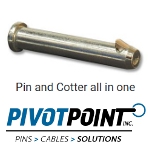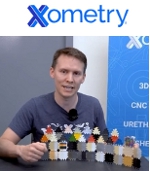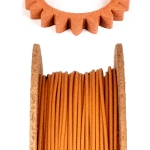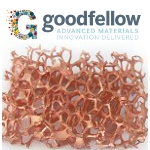 |
| July 17, 2018 | Volume 14 Issue 27 |
Mechanical News & Products
Designfax weekly eMagazine
Archives
Partners
Manufacturing Center
Product Spotlight
Modern Applications News
Metalworking Ideas For
Today's Job Shops
Tooling and Production
Strategies for large
metalworking plants
What's a SLIC Pin®? Pin and cotter all in one!
 The SLIC Pin (Self-Locking Implanted Cotter Pin) from Pivot Point is a pin and cotter all in one. This one-piece locking clevis pin is cost saving, fast, and secure. It functions as a quick locking pin wherever you need a fast-lock function. It features a spring-loaded plunger that functions as an easy insertion ramp. This revolutionary fastening pin is very popular and used successfully in a wide range of applications.
The SLIC Pin (Self-Locking Implanted Cotter Pin) from Pivot Point is a pin and cotter all in one. This one-piece locking clevis pin is cost saving, fast, and secure. It functions as a quick locking pin wherever you need a fast-lock function. It features a spring-loaded plunger that functions as an easy insertion ramp. This revolutionary fastening pin is very popular and used successfully in a wide range of applications.
Learn more.
Engineering challenge: Which 3D-printed parts will fade?
 How does prolonged exposure to intense UV light impact 3D-printed plastics? Will they fade? This is what Xometry's Director of Application Engineering, Greg Paulsen, set to find out. In this video, Paulsen performs comprehensive tests on samples manufactured using various additive processes, including FDM, SLS, SLA, PolyJet, DLS, and LSPc, to determine their UV resistance. Very informative. Some results may surprise you.
How does prolonged exposure to intense UV light impact 3D-printed plastics? Will they fade? This is what Xometry's Director of Application Engineering, Greg Paulsen, set to find out. In this video, Paulsen performs comprehensive tests on samples manufactured using various additive processes, including FDM, SLS, SLA, PolyJet, DLS, and LSPc, to determine their UV resistance. Very informative. Some results may surprise you.
View the video.
Copper filament for 3D printing
 Virtual Foundry, the company that brought us 3D-printable lunar regolith simulant, says its popular Copper Filamet™ (not a typo) is "back in stock and ready for your next project." This material is compatible with any open-architecture FDM/FFF 3D printer. After sintering, final parts are 100% pure copper. Also available as pellets. The company says this is one of the easiest materials to print and sinter. New Porcelain Filamet™ available too.
Virtual Foundry, the company that brought us 3D-printable lunar regolith simulant, says its popular Copper Filamet™ (not a typo) is "back in stock and ready for your next project." This material is compatible with any open-architecture FDM/FFF 3D printer. After sintering, final parts are 100% pure copper. Also available as pellets. The company says this is one of the easiest materials to print and sinter. New Porcelain Filamet™ available too.
Learn more and get all the specs.
Copper foam -- so many advantages
 Copper foam from Goodfellow combines the outstanding thermal conductivity of copper with the structural benefits of a metal foam. These features are of particular interest to design engineers working in the fields of medical products and devices, defense systems and manned flight, power generation, and the manufacture of semiconductor devices. This product has a true skeletal structure with no voids, inclusions, or entrapments. A perennial favorite of Designfax readers.
Copper foam from Goodfellow combines the outstanding thermal conductivity of copper with the structural benefits of a metal foam. These features are of particular interest to design engineers working in the fields of medical products and devices, defense systems and manned flight, power generation, and the manufacture of semiconductor devices. This product has a true skeletal structure with no voids, inclusions, or entrapments. A perennial favorite of Designfax readers.
Learn more.
Full-color 3D-printing Design Guide from Xometry
 With Xometry's PolyJet 3D-printing service, you can order full-color 3D prints easily. Their no-cost design guide will help you learn about different aspects of 3D printing colorful parts, how to create and add color to your models, and best practices to keep in mind when printing in full color. Learn how to take full advantage of the 600,000 unique colors available in this flexible additive process.
With Xometry's PolyJet 3D-printing service, you can order full-color 3D prints easily. Their no-cost design guide will help you learn about different aspects of 3D printing colorful parts, how to create and add color to your models, and best practices to keep in mind when printing in full color. Learn how to take full advantage of the 600,000 unique colors available in this flexible additive process.
Get the Xometry guide.
Tech Tip: How to create high-quality STL files for 3D prints
 Have you ever 3D printed a part that had flat spots or faceted surfaces where smooth curves were supposed to be? You are not alone, and it's not your 3D printer's fault. According to Markforged, the culprit is likely a lack of resolution in the STL file used to create the part.
Have you ever 3D printed a part that had flat spots or faceted surfaces where smooth curves were supposed to be? You are not alone, and it's not your 3D printer's fault. According to Markforged, the culprit is likely a lack of resolution in the STL file used to create the part.
Read this detailed and informative Markforged blog.
Test your knowledge: High-temp adhesives
 Put your knowledge to the test by trying to answer these key questions on how to choose the right high-temperature-resistant adhesive. The technical experts from Master Bond cover critical information necessary for the selection process, including questions on glass transition temperature and service temperature range. Some of the answers may surprise even the savviest of engineers.
Put your knowledge to the test by trying to answer these key questions on how to choose the right high-temperature-resistant adhesive. The technical experts from Master Bond cover critical information necessary for the selection process, including questions on glass transition temperature and service temperature range. Some of the answers may surprise even the savviest of engineers.
Take the quiz.
Engineer's Toolbox: How to pin a shaft and hub assembly properly
 One of the primary benefits of using a coiled spring pin to affix a hub or gear to a shaft is the coiled pin's ability to prevent hole damage. Another is the coiled pin absorbs wider hole tolerances than any other press-fit pin. This translates to lower total manufacturing costs of the assembly. However, there are a few design guidelines that must be adhered to in order to achieve the maximum strength of the pinned system and prevent damage to the assembly.
One of the primary benefits of using a coiled spring pin to affix a hub or gear to a shaft is the coiled pin's ability to prevent hole damage. Another is the coiled pin absorbs wider hole tolerances than any other press-fit pin. This translates to lower total manufacturing costs of the assembly. However, there are a few design guidelines that must be adhered to in order to achieve the maximum strength of the pinned system and prevent damage to the assembly.
Read this very informative SPIROL article.
What's new in Creo Parametric 11.0?
 Creo Parametric 11.0 is packed with productivity-enhancing updates, and sometimes the smallest changes make the biggest impact in your daily workflows. Mark Potrzebowski, Technical Training Engineer, Rand 3D, runs through the newest functionality -- from improved surface modeling tools to smarter file management and model tree navigation. Videos provide extra instruction.
Creo Parametric 11.0 is packed with productivity-enhancing updates, and sometimes the smallest changes make the biggest impact in your daily workflows. Mark Potrzebowski, Technical Training Engineer, Rand 3D, runs through the newest functionality -- from improved surface modeling tools to smarter file management and model tree navigation. Videos provide extra instruction.
Read the full article.
What's so special about wave springs?
 Don't settle for ordinary springs. Opt for Rotor Clip wave springs. A wave spring is a type of flat wire compression spring characterized by its unique waveform-like structure. Unlike traditional coil springs, wave springs offer an innovative solution to complex engineering challenges, producing forces from bending, not torsion. Their standout feature lies in their ability to compress and expand efficiently while occupying up to 50% less axial space than traditional compression springs. Experience the difference Rotor Clip wave springs can make in your applications today!
Don't settle for ordinary springs. Opt for Rotor Clip wave springs. A wave spring is a type of flat wire compression spring characterized by its unique waveform-like structure. Unlike traditional coil springs, wave springs offer an innovative solution to complex engineering challenges, producing forces from bending, not torsion. Their standout feature lies in their ability to compress and expand efficiently while occupying up to 50% less axial space than traditional compression springs. Experience the difference Rotor Clip wave springs can make in your applications today!
View the video.
New Standard Parts Handbook from JW Winco
 JW Winco's printed Standard Parts Handbook is a comprehensive 2,184-page reference that supports designers and engineers with the largest selection of standard parts categorized into three main groups: operating, clamping, and machine parts. More than 75,000 standard parts can be found in this valuable resource, including toggle clamps, shaft collars, concealed multiple-joint hinges, and hygienically designed components.
JW Winco's printed Standard Parts Handbook is a comprehensive 2,184-page reference that supports designers and engineers with the largest selection of standard parts categorized into three main groups: operating, clamping, and machine parts. More than 75,000 standard parts can be found in this valuable resource, including toggle clamps, shaft collars, concealed multiple-joint hinges, and hygienically designed components.
Get your Standard Parts Handbook today.
Looking to save space in your designs?
 Watch Smalley's quick explainer video to see how engineer Frank improved his product designs by switching from traditional coil springs to compact, efficient wave springs. Tasked with making his products smaller while keeping costs down, Frank found wave springs were the perfect solution.
Watch Smalley's quick explainer video to see how engineer Frank improved his product designs by switching from traditional coil springs to compact, efficient wave springs. Tasked with making his products smaller while keeping costs down, Frank found wave springs were the perfect solution.
View the video.
Top die casting design tips
 You can improve the design and cost of your die cast parts with these top tips from Xometry's Joel Schadegg. Topics include: Fillets and Radii, Wall Thicknesses, Ribs and Metal Savers, Holes and Windows, Parting Lines, and more. Follow these recommendations so you have the highest chance of success with your project.
You can improve the design and cost of your die cast parts with these top tips from Xometry's Joel Schadegg. Topics include: Fillets and Radii, Wall Thicknesses, Ribs and Metal Savers, Holes and Windows, Parting Lines, and more. Follow these recommendations so you have the highest chance of success with your project.
Read the full Xometry article.
What's the latest from 3D Systems? Innovations for different industries, processes
 3D Systems unveiled several new solutions at the RAPID+TCT 2025 show in April designed to change the way industries innovate. From new 3D printers and materials for high-mix, low-volume applications to marked improvements in how investment casting can be done, learn what is the state of the art from the original inventors of 3D printing.
3D Systems unveiled several new solutions at the RAPID+TCT 2025 show in April designed to change the way industries innovate. From new 3D printers and materials for high-mix, low-volume applications to marked improvements in how investment casting can be done, learn what is the state of the art from the original inventors of 3D printing.
Read the full article.
Clever! Indexing plungers with chamfered pins
 JW Winco has developed a new type of indexing plunger -- GN 824 -- that can independently latch into edges and grooves. This is made possible by a chamfered plunger pin. When the chamfered pin encounters a raised latching geometry, it retracts and then springs back out again once it reaches the latching point. This new indexing plunger can be ordered with axial thread for fastening and a black plastic knob for operating the indexing plunger. In a clever design, the plunger pin can be adjusted by 360 degrees to ensure that it encounters the mating surface perpendicularly. This hardware is well suited for transport frames, mechanisms, or covers that need to be locked in place quickly and securely, especially without the need for manual intervention.
JW Winco has developed a new type of indexing plunger -- GN 824 -- that can independently latch into edges and grooves. This is made possible by a chamfered plunger pin. When the chamfered pin encounters a raised latching geometry, it retracts and then springs back out again once it reaches the latching point. This new indexing plunger can be ordered with axial thread for fastening and a black plastic knob for operating the indexing plunger. In a clever design, the plunger pin can be adjusted by 360 degrees to ensure that it encounters the mating surface perpendicularly. This hardware is well suited for transport frames, mechanisms, or covers that need to be locked in place quickly and securely, especially without the need for manual intervention.
Learn more.
New way to make wet suits better: 'Artificial blubber' protects divers in frigid water
By David Chandler, MIT
When Navy SEALs carry out dives in Arctic waters, or when rescue teams are diving under ice-covered rivers or ponds, the survival time even in the best wetsuits is very limited -- as little as tens of minutes, and the experience can be extremely painful at best. Finding ways of extending that survival time without hampering mobility has been a priority for the U.S. Navy and research divers, as a pair of MIT engineering professors learned during a recent program that took them to a variety of naval facilities.
That visit led to a two-year collaboration that has now yielded a dramatic result: a simple treatment that can improve the survival time for a conventional wetsuit by a factor of three, the scientists say.
The findings, which could be applied immediately, were reported recently in the journal RSC Advances, in a paper by Michael Strano, the Carbon P. Dubbs Professor of Chemical Engineering; Jacopo Buongiorno, the TEPCO Professor and associate head of the Department of Nuclear Science and Engineering; and five others at MIT and George Mason University.
The process they discovered works by simply placing the standard neoprene wetsuit inside a pressure tank autoclave no bigger than a beer keg, filled with a heavy inert gas, for about a day. The treatment then lasts for about 20 hours, far longer than anyone would spend on a dive, explains Buongiorno, who is an avid wetsuit user himself. The process could also be done in advance, with the wetsuit placed in a sealed bag to be opened just before use, he says.

From left, graduate student Anton Cottrill, Professor Jacopo Buongiorno, and Professor Michael Strano try out their neoprene wetsuits at a pool at MIT's athletic center. Cottrill is holding the pressure tank used to treat the wetsuits with xenon or krypton. [Photo: Susan Young]
Though Buongiorno and Strano are both on the MIT faculty, they had never met until they were both part of the Defense Science Study Group for the Department of Defense. "We got to visit a lot of bases and met with all kinds of military people up to four-star generals," says Buongiorno, whose specialty in nuclear engineering has to do with heat transfer, especially through water. They learned about the military's particular needs and were asked to design a technological project to address one of those needs. After meeting with a group of Navy SEALs, the elite special-operations diving corps, they decided the need for longer-lasting protection in icy waters was one that they could take on.
They looked at the different strategies that various animals use to survive in these frigid waters and found three types: air pockets trapped in fur or feathers, as with otters and penguins; internally generated heat, as with some animals and fish (including great white sharks, which, surprisingly, are warm-blooded); or a layer of insulating material that greatly slows heat loss from the body, as with seals' and whales' blubber.
In the end, after simulations and lab tests, they ended up with a combination of two of these -- a blubber-like insulating material that also makes use of trapped pockets of gas, although in this case the gas is not air but a heavy inert gas, namely xenon or krypton.

The material that has become standard for wetsuits is neoprene, an inexpensive material that is a mix of synthetic rubber materials processed into a kind of foam, producing a closed-cell structure similar to styrofoam. Trapped within that structure, occupying more than two-thirds of the volume and accounting for half of the heat that gets transferred through it, are pockets of air.
Strano and Buongiorno found that if the trapped air is replaced with xenon or krypton, the material's insulating properties increase dramatically. The result, they say, is a material with the lowest heat transfer of any wetsuit ever made. "We set a world record for the world's lowest thermal conductivity garment," Strano says -- conductivity almost as low as air itself. "It's like wearing a coat of air."
They found this could improve survivability in water colder than 10 deg C, raising it from less than one hour to two or three hours.
The result could be a boon not just to those in the most extreme environments, but to anyone who uses wetsuits in cold waters, including swimmers, athletes, and surfers, as well as professional divers of all kinds.

Holes in a wetsuit reveal the thickness of the neoprene material. The new MIT-developed treatment could provide the same amount of insulation with just half the thickness, the researchers say. [Photo: Susan Young]
"As part of this project, I interviewed dozens of wetsuit users, including a professional underwater photographer, divers working at the New England Aquarium, a Navy SEAL friend of mine, and random surfers I approached on a San Diego beach," says co-author and former MIT postdoc Jeffrey Moran PhD '17, who is now an assistant professor at George Mason University. "The feedback was essentially unanimous -- there is an urgent need for warmer wetsuits, both in and out of the Arctic. People's eyes lit up when I told them about our results."
Currently, the only viable cold-water alternatives to wetsuits are dry suits, which have a layer of air between the suit and the skin that must be maintained using a hose and a pump, or a warm-water suit, which similarly requires a hose and pump connection. In either case, a failure of the pump or a cut or tear in the suit can result is a quick loss of insulation that can be life threatening within minutes.
But the xenon- or krypton-infused neoprene requires no such support system and has no way of quickly losing its insulating properties, and so does not carry that risk. "We can take anyone's neoprene wetsuit and pressurize it with xenon or krypton for high-performance operations," Strano says. MIT graduate student Anton Cottrill, a co-author of the paper, adds, "The gas actually infuses more quickly during treatment than it discharges during its use in an aquatic environment."
Another possibility, they say, is to produce a wetsuit with the same insulating properties as present ones, but with a small fraction of the thickness, allowing more comfort and freedom of movement that might be appealing to athletes. "Almost everyone I interviewed also said they wanted a wetsuit that was easier to move around in and to put on and take off," says Moran. "The results of this project suggest that we could make wetsuits that provide the same thermal insulation as traditional ones, but are about half as thick."
One next step in their research is to look at ways of making a long-term, stable version of a xenon-infused neoprene, perhaps by bonding a protective layer over it, they say. In the meantime, the team is also looking for opportunities to treat the neoprene garments of interested users so that they can collect performance data.
"Their approach to the problem is a remarkable feat of materials science and also very clever engineering," says John Dabiri, a professor of civil and environmental engineering and of mechanical engineering at Stanford University, who was not involved in this work. "They've managed to achieve something close to an ideal air-like thermal barrier, and they've accomplished this using materials that are more compatible with end-uses like scuba diving than previous concepts. The overall performance characteristics could be a game-changer for a variety of applications."
And Charles Amsler, a professor of biology at the University of Alabama at Birmingham, who has made almost 950 research dives in Antartica but was not connected with this research, says, "It could be very beneficial in cases where flexibility, lack of bulkiness, swimming speed, or reduced drag with diver propulsion vehicles are at a premium, or where environmental hazards make the chance of dive suit puncture high. Normally, diver thermal protection in very cold water is by use of dry suits rather than wetsuits. But wetsuits typically allow much more diver flexibility."
Amsler adds, "One concern with drysuits is that ... should the suit be badly punctured, a diver loses much or all of that insulation. ... In a deep or long-duration dive where staged decompression would be required to prevent decompression illness ("the bends"), wearing one of these thermally enhanced wetsuits would significantly reduce the chance that a diver with a punctured suit would have to make the choice between potentially fatal hypothermia and potentially debilitating or fatal decompression illness."
Published July 2018
Rate this article
View our terms of use and privacy policy

